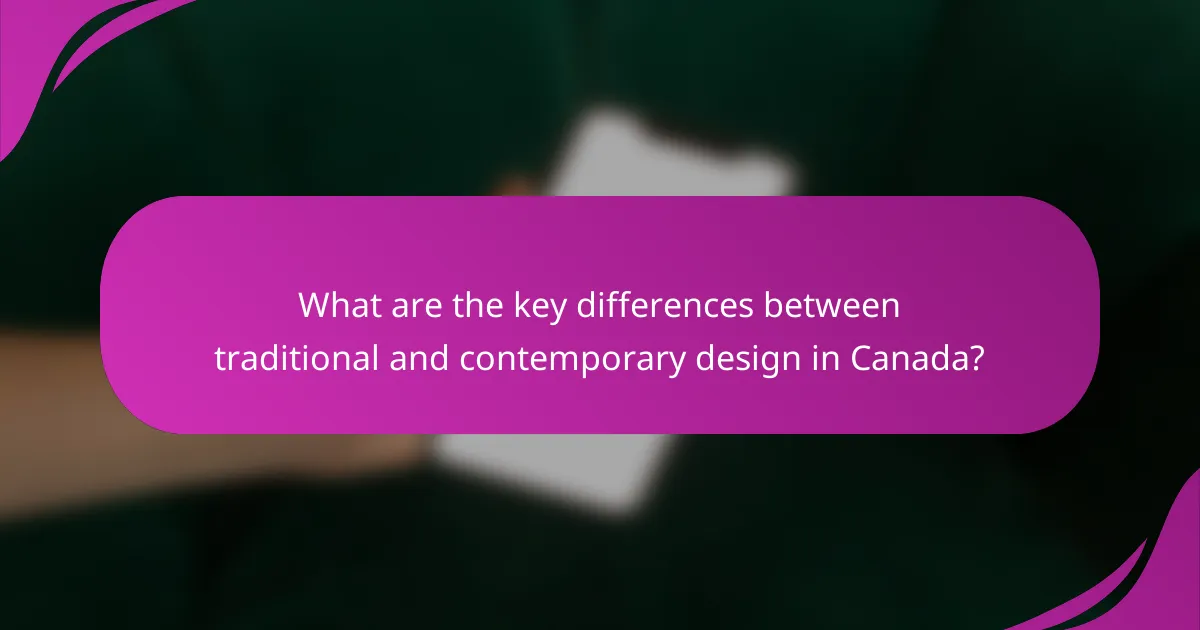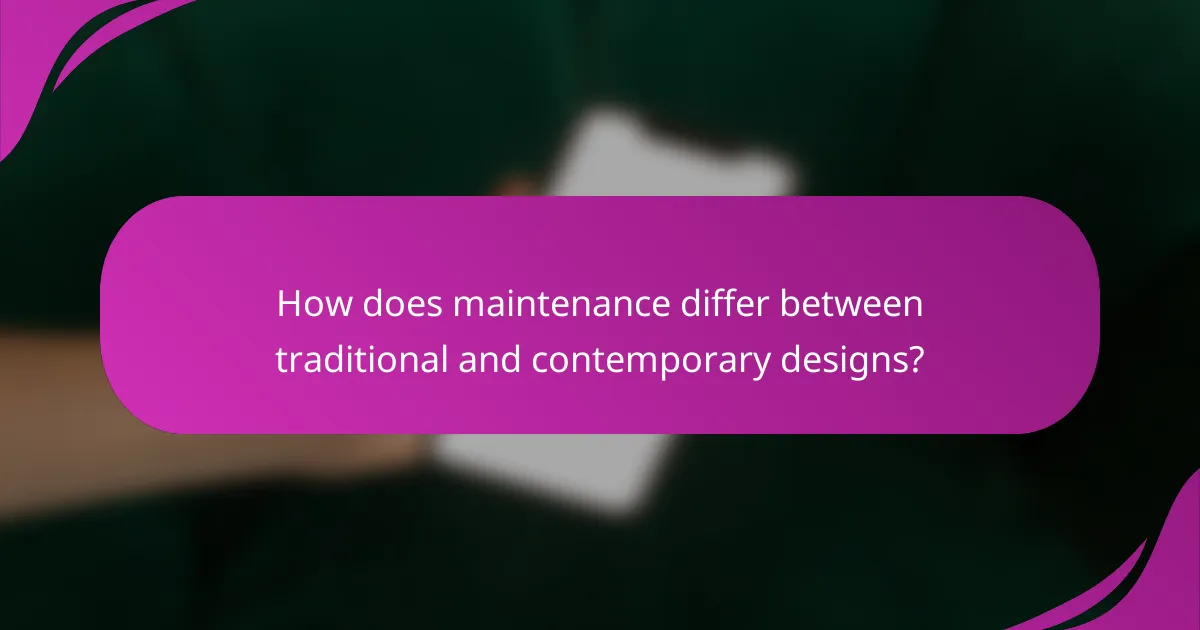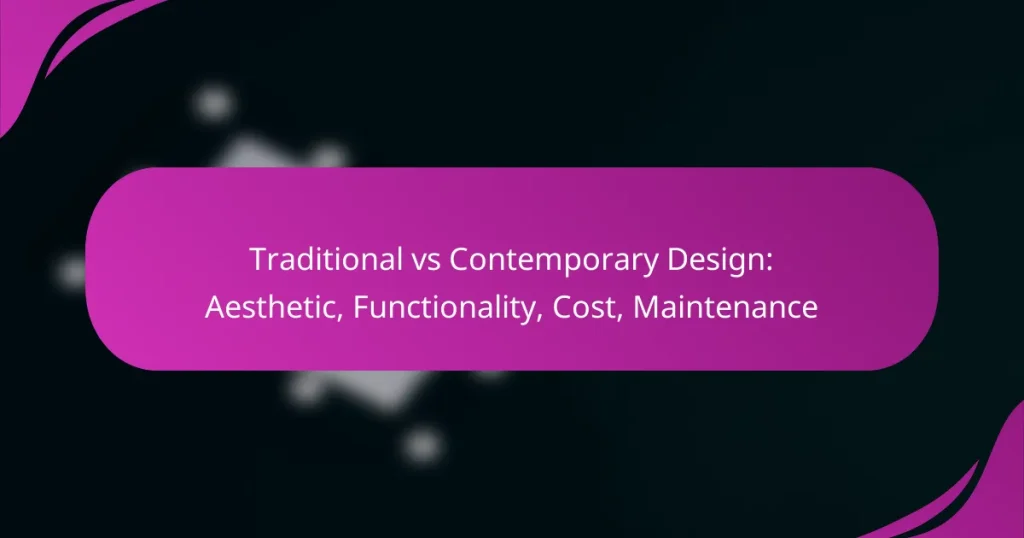Exploring the contrast between traditional and contemporary design reveals distinct approaches to aesthetics, functionality, cost, and maintenance. While traditional design celebrates historical elements and craftsmanship, contemporary design prioritizes modernity and efficiency. Understanding these differences allows homeowners to align their choices with personal style, practical needs, and budget considerations.

What are the key differences between traditional and contemporary design in Canada?
Traditional design in Canada often emphasizes classic aesthetics and historical references, while contemporary design focuses on modernity and minimalism. Understanding these differences can help homeowners make informed choices based on their style preferences, functionality needs, and budget constraints.
Aesthetic contrasts
Traditional design features ornate details, rich textures, and a warm color palette, often drawing inspiration from historical styles like Victorian or Colonial. In contrast, contemporary design embraces clean lines, open spaces, and a neutral color scheme, prioritizing simplicity and functionality.
For example, traditional interiors may include heavy drapes and intricate moldings, whereas contemporary spaces often utilize large windows and minimalistic furnishings to create a sense of openness. This aesthetic difference can significantly influence the overall feel of a home.
Functional variations
Functionality in traditional design often revolves around creating cozy, inviting spaces that encourage social interaction, with rooms designed for specific purposes. Contemporary design, however, tends to favor multifunctional spaces that adapt to the changing needs of modern living.
For instance, a traditional dining room may be used solely for meals, while a contemporary design might incorporate a dining area that doubles as a workspace. This flexibility can be particularly advantageous in urban settings where space is limited.
Cost considerations
When comparing costs, traditional design may involve higher expenses due to elaborate craftsmanship and premium materials, such as hardwood and custom cabinetry. Contemporary design can sometimes be more budget-friendly, as it often utilizes simpler materials and mass-produced items.
However, the long-term costs can vary based on maintenance and durability. Investing in quality traditional elements may yield longevity, while contemporary designs might require more frequent updates or replacements due to changing trends.
Maintenance requirements
Traditional designs often require more upkeep, as intricate details and high-quality materials can be sensitive to wear and tear. Regular maintenance, such as refinishing woodwork or cleaning delicate fabrics, is essential to preserve their beauty.
Conversely, contemporary designs typically prioritize low-maintenance materials and finishes, making them easier to care for. For example, sleek surfaces and synthetic materials can often be cleaned with minimal effort, appealing to busy homeowners.

How does traditional design influence aesthetic choices?
Traditional design significantly impacts aesthetic choices by emphasizing timeless elements that evoke a sense of history and craftsmanship. This style often incorporates classic features that create a warm and inviting atmosphere, appealing to those who value heritage and authenticity in their spaces.
Classic materials and textures
Traditional design often utilizes classic materials such as wood, stone, and brick, which contribute to a sense of durability and warmth. Textures play a crucial role, with options like handwoven fabrics, intricate carvings, and aged finishes that enhance the overall aesthetic. For instance, oak and walnut are popular choices for furniture, while natural stone can be used for flooring or countertops.
When selecting materials, consider their longevity and maintenance requirements. High-quality wood may require periodic refinishing, while stone surfaces can be more resilient but may need sealing to prevent staining. Aim for a balance between beauty and practicality in your choices.
Color palettes and patterns
Traditional design typically features rich, muted color palettes that evoke a sense of comfort and nostalgia. Colors like deep reds, forest greens, and warm browns are common, often complemented by neutral tones to create a harmonious environment. Patterns such as florals, damasks, and plaids can add visual interest while maintaining a cohesive look.
When choosing colors and patterns, consider the scale of the space. Lighter colors can make a room feel larger, while darker shades can create intimacy. Mixing patterns can be effective, but aim for a common color thread to unify the design. Avoid overly bold or modern patterns that may clash with the traditional aesthetic.

What are the functional advantages of contemporary design?
Contemporary design offers several functional advantages, primarily focusing on maximizing space, enhancing usability, and integrating modern technology. These elements contribute to a more efficient and user-friendly environment, making contemporary design a popular choice for both residential and commercial spaces.
Space optimization
Space optimization in contemporary design emphasizes open layouts and multifunctional areas. This approach allows for better flow and utilization of available square footage, making smaller spaces feel larger and more inviting.
For instance, furniture that serves multiple purposes, such as a sofa bed or a coffee table with storage, can significantly enhance the functionality of a room. When planning a contemporary space, consider using modular furniture that can be rearranged easily to adapt to different needs.
Integration of technology
Contemporary design seamlessly incorporates technology to improve functionality and convenience. Smart home systems, energy-efficient appliances, and integrated audio-visual setups are common features that enhance the user experience.
When selecting technology for a contemporary space, prioritize devices that offer compatibility and ease of use. For example, smart thermostats can help manage energy costs effectively, while automated lighting systems can create ambiance and improve security.

What are the cost implications of choosing traditional vs contemporary design?
The cost implications of choosing traditional versus contemporary design can vary significantly based on factors like materials, labor, and long-term value. Traditional designs often require higher initial investments due to craftsmanship and premium materials, while contemporary designs may offer cost-effective options but can also lead to higher maintenance expenses over time.
Initial investment differences
When comparing initial investments, traditional design typically demands a larger upfront cost. This is often due to the use of high-quality materials, intricate detailing, and skilled labor required for construction. For example, a traditional home might range from 10% to 30% more expensive than a contemporary one, depending on the complexity of the design.
In contrast, contemporary designs often utilize modern materials and construction techniques that can reduce costs. Prefabricated elements and simpler lines can lead to savings, making contemporary options appealing for budget-conscious buyers. However, it’s essential to consider the potential trade-offs in quality and durability.
Long-term value and resale
Long-term value and resale potential can differ markedly between traditional and contemporary designs. Traditional homes often appreciate well due to their timeless appeal and established neighborhoods, making them attractive to buyers seeking character and history. This can translate to higher resale values, sometimes exceeding initial investments by a significant margin.
On the other hand, contemporary designs may appeal to a younger demographic, which can influence their resale value positively. However, trends in contemporary design can shift rapidly, potentially leading to depreciation if styles change. It’s crucial to consider the local market and buyer preferences when evaluating long-term value.

How does maintenance differ between traditional and contemporary designs?
Maintenance for traditional and contemporary designs varies significantly in terms of materials and upkeep requirements. Traditional designs often require more frequent care due to their intricate details and materials, while contemporary designs typically emphasize durability and ease of maintenance.
Durability of materials
Traditional designs frequently utilize natural materials such as wood, stone, and plaster, which can be susceptible to wear over time. These materials may require regular sealing, painting, or refinishing to maintain their appearance and integrity.
In contrast, contemporary designs often incorporate synthetic materials like fiberglass, metal, and engineered wood, which are designed for longevity and resistance to environmental factors. These materials generally withstand the test of time better and require less frequent replacement.
Ease of upkeep
Traditional designs can demand significant upkeep, including dusting intricate moldings, polishing wood surfaces, and maintaining gardens or landscaping that complement the architecture. This can lead to higher ongoing costs and time commitments.
Contemporary designs prioritize simplicity and functionality, often featuring open spaces and minimalistic aesthetics that are easier to clean and maintain. For example, surfaces made from composite materials can usually be wiped down quickly, reducing the time spent on upkeep.

What factors should you consider when choosing between traditional and contemporary design?
When choosing between traditional and contemporary design, consider personal style preferences, functionality, cost, and maintenance. Each factor plays a crucial role in how well a design aligns with your lifestyle and aesthetic goals.
Personal style preferences
Your personal style preferences are fundamental in deciding between traditional and contemporary design. Traditional design often features classic elements, intricate details, and a sense of history, while contemporary design leans towards minimalism, clean lines, and innovative materials.
To determine your preference, think about your existing decor and the atmosphere you wish to create. If you enjoy rich textures and ornate features, traditional design may resonate more with you. Conversely, if you prefer a sleek, uncluttered look, contemporary design might be the better choice.


